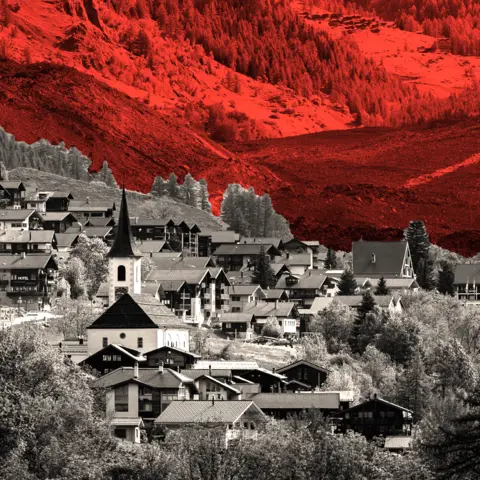The Swiss Alps, a symbol of beauty and culture, are now facing an existential crisis due to the impactful consequences of climate change. A recent article details the catastrophic event that unfolded in a small village named Blatten, situated in the picturesque Loetschental valley. The village experienced a devastating glacier collapse that wiped it off the map, leading to urgent discussions on the viability of preserving alpine communities amidst mounting natural hazards.
Matthias Bellwald, the mayor of a nearby village, was among those affected. Just miles away from Blatten, he recalls walking through the streets of his town, now desolate, filled with memories of local camaraderie. The disaster claimed the village’s residents, who had to evacuate days prior due to warnings of instability from geologists. Many like Lukas Kalbermatten lost family businesses, including a hotel that had been in his possession for generations. The emotional toll is quantifiable, as Kalbermatten expresses sorrow over the loss of childhood memories tied to the now-destroyed village.
The aftermath of the disaster left the community grappling with the high financial costs of rebuilding Blatten, estimated to reach upwards of $1 million per resident, with a total expenditure potentially in the hundreds of millions of dollars. Financial support from the government, local donations, and insurance payouts is helping, but skepticism remains regarding the worth of such extensive investments to maintain a site that may be increasingly susceptible to geological triggers.
Climate scientists are now warning that the likelihood of such destabilizing events might grow due to global warming, raising the question of how many more villages within the mountainous expanse of Switzerland might suffer a similar fate. Many residents in the affected regions choose not to acknowledge climate change as a contributing factor to these natural disasters, viewing the events as rare anomalies instead. However, glaciologist Matthias Huss underscores the detrimental role climate change plays in destabilizing these crucial ecosystems, noting the interdependence of glaciers, permafrost, and alpine safety.
Interestingly, Switzerland, well-known for its extensive investment in protective structures, spends approximately $500 million annually to shield its vulnerable areas. Yet, experts argue this may not suffice, with some studies suggesting a need for funding that is six times higher. The crux of this challenge lies not only in economic feasibility but also challenges the cultural narrative surrounding the Swiss identity and attachment to these mountain regions. As alpine traditions begin to wane alongside village stability, there emerges an urgent dialogue questioning the future of these communities.
Blatten’s tragic story is likely to be a catalyst for broader discussions on risk management and village evacuations across the Swiss landscape. While traditional views emphasize preserving these communities, opinions are divided on whether this is financially viable or rational – particularly as climate change intensifies the unpredictability of alpine environments.
As concern grows, the debate also delves into the philosophy of “heimat,” a term encompassing home and identity that binds many Swiss people to their mountainous heritage. For several, “heimat” evokes deep emotional ties to the land, thereby complicating discussions of relocation in the face of danger. Kalbermatten questions the concept of abandoning their ancestral lands, reflecting a broader cultural struggle over preserving historical and communal identities.
Events like the collapse of Blatten bring urgency to consider how far society should push to save its heritage against relentless climactic forces. While many express a heartfelt desire to retain their connection to the mountains, the realities of a warming climate signal an inevitable transformation is needed to adapt to an unpredictable future, reshaping the socio-cultural fabric of these thriving alpine communities.
In conclusion, the situation in Blatten is not merely a localized incident but rather a microcosm of the global climate crisis, provoking profound reflections on tradition, community, and the cost of survival in a changing world. As the recovery from this crisis begins, the Swiss Alpine regions stand at a crossroads between embracing advancement or holding tightly to a history that may become untenable.












